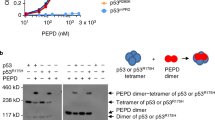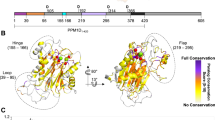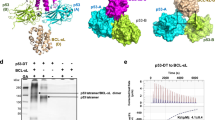Abstract
Phosphorylation of the p53 tumor suppressor protein is likely to play an important role in regulating its activity. To study the regulatory role of potential phosphorylation sites within the N-terminal transactivation domain of human p53 (hp53), a series of p53 serine mutants were evaluated for transcriptional transactivation and sequence specific DNA binding. The role of these mutations in regulating p53-mediated growth suppression and programmed cell death was examined. This mutational analysis comprised serine residues located at positions 6, 9, 15, 20, 33 and 37 of human p53. Substitution of serine for alanine, either at individual residues or at all six residues together, did not affect the suppression of cell growth and cell transformation, or the ability to bind DNA specifically and to transactivate different promoters, nor did it alter p53 expression. However, the ability of p53 to induce apoptosis was impaired by specific serine substitutions. Mutations in all six N-terminal serines together reduced the apoptotic activity of p53 in H1299 cells by 50%. Analysis of individual mutants revealed that mutations in serine 15 and 20 are primarily responsible for this impairment. Our results suggest that these serines play a role in the regulation of p53-mediated apoptosis.
This is a preview of subscription content, access via your institution
Access options
Subscribe to this journal
Receive 50 print issues and online access
$259.00 per year
only $5.18 per issue
Buy this article
- Purchase on Springer Link
- Instant access to full article PDF
Prices may be subject to local taxes which are calculated during checkout





Similar content being viewed by others
References
Addison C, Jenkins JR and Sturzbecher HW. . 1990 Oncogene 5: 423–426.
Banin S, Moyal L, Shieh S, Taya Y, Anderson CW, Chessa L, Smorodinsky NI, Prives C, Reiss Y, Shiloh Y and Ziv Y. . 1998 Science 281: 1674–1677.
Bates S and Vousden KH. . 1996 Curr. Opin. Genet. Dev. 6: 12–18.
Bischoff JR, Friedman PN, Marshak DR, Prives C and Beach D. . 1990 Proc. Natl. Acad. Sci. USA 87: 4766–4770.
Canman CE, Lim DS, Cimprich KA, Taya Y, Tamai K, Sakaguchi K, Appella E, Kastan MB and Siliciano JD. . 1998 Science 281: 1677–1679.
Crook T, Marston NJ, Sara EA and Vousden KH. . 1994 Cell 79: 817–827.
Darzynkiewicz Z, Bruno S, Del Bino G, Gorczyca W, Hotz MA, Lassota P and Traganos F. . 1992 Cytometry 13: 795–808.
Fiscella M, Ullrich SJ, Zambrano N, Shields MT, Lin D, Lees Miller SP, Anderson CW, Mercer WE and Appella E. . 1993 Oncogene 8: 1519–1528.
Fiscella M, Zambrano N, Ullrich SJ, Unger T, Lin D, Cho B, Mercer WE, Anderson CW and Appella E. . 1994 Oncogene 9: 3249–3257.
Fuchs B, O'connor D, Fallis L, Sheidtmann KH and Lu X. . 1995 Oncogene 10: 789–793.
Fuchs SY, Dolan L, Davis RJ and Ronai Z. . 1996 Oncogene 13: 1531–1535.
Funk WD, Pak DT, Karas RH, Wright WE and Shay JW. . 1992 Mol. Cell. Biol. 12: 2866–2871.
Gonzalez GA and Montminy MR. . 1989 Cell 59: 675–680.
Gottleib TM and Oren M. . 1996 Biochim. Biophys. Acta 1287: 77–102.
Hall SR, Campbell LE and Meek DW. . 1996 Nucl. Acids Res. 24: 1119–1126.
Hao MM, Lowy AM, Kapoor M, Deffie A, Liu G and Lozano G. . 1996 J. Biol. Chem. 271: 29380–29385.
Haupt Y, Barak Y and Oren M. . 1996 EMBO, J. 15: 1596–1606.
Haupt Y, Maya R, Kazaz A and Oren M. . 1997 Nature 387: 296–299.
Haupt Y and Oren M. . 1996 Behring. Inst. Mitt. 97: 32–59.
Haupt Y, Rowan S, Shaulian E, Vousden KH and Oren M. . 1995 Genes Dev. 9: 2170–2183.
Hupp TR, Meek DW, Midgley CA and Lane DP. . 1992 Cell 71: 875–886.
Ko LJ, Shieh SY, Chen X, Jayaraman L, Tamai K, Taya Y, Prives C and Pan ZQ. . 1997 Mol. Cell Biol. 17: 7220–7229.
Kubbutat MH, Jones SN and Vousden KH. . 1997 Nature 387: 299–303.
Kussie PH, Gorina S, Marechal V, Elenbaas B, Moreau J, Levine AJ and Pavletich NP. . 1996 Science 274: 948–953.
Lees Miller SP, Sakaguchi K, Ullrich SJ, Appella E and Anderson CW. . 1992 Mol. Cell. Biol. 12: 5041–5049.
Levine AJ. . 1997 Cell 88: 323–331.
Lin R, Beauparlant P, Makris C, Meloche S and Hiscott J. . 1996 Mol. Cell. Biol. 16: 1401–1409.
Lohrum M and Scheidtmann KH. . 1996 Oncogene 13: 2527–2539.
Lu H, Fisher RP, Bailey P and Levine AJ. . 1997 Mol. Cell. Biol. 17: 5923–5934.
Lu H and Levine AJ. . 1995 Proc. Natl. Acad. Sci. USA 92: 5154–5158.
Mayr GA, Reed M, Wang P, Wang Y, Schweds JF and Tegtmeyer P. . 1995 Cancer Res. 55: 2410–2417.
Meek DW. . 1998 Cell Signal 10: 159–166.
Meek DW, Simon S, Kikkawa U and Eckhart W. . 1990 EMBO J. 9: 3253–3260.
Mietz JA, Unger T, Huibregtse JM and Howley PM. . 1992 EMBO J. 11: 5013–5020.
Milczarek GJ, Martinez J and Bowden GT. . 1997 Life Sci. 60: 1–11.
Milne DM, Palmer RH and Meek DW. . 1992 Nucleic Acids Research 20: 5565–5570.
Miyashita T, Harigai M, Hanada M and Reed JC. . 1994 Cancer Res. 54: 3131–3135.
Miyashita T and Reed JC. . 1995 Cell 80: 293–299.
Momand J and Zambetti GP. . 1997 J. Cell Biochem. 64: 343–352.
Murphy M, Hinman A and Levine AJ. . 1996 Genes Dev. 10: 2971–2980.
Naumovski L and Cleary ML. . 1996 Mol. Cell. Biol. 16: 3884–3892.
Polyak K, Xia Y, Zweier JL, Kinzler KW and Vogelstein B. . 1997 Nature 389: 300–305.
Prisco M, Hongo A, Rizzo MG, Sacchi A and Baserga R. . 1997 Mol. Cell. Biol. 17: 1084–1092.
Prives C. . 1998 Cell 95: 5–8.
Shieh SY, Ikeda M, Taya Y and Prives C. . 1997 Cell 91: 325–334.
Siliciano JD, Canman CE, Taya Y, Sakaguchi K, Appella E and Kastan MB. . 1997 Genes Dev. 11: 3471–3481.
Smeal T, Binetruy B, Mercola DA, Birrer M and Karin M. . 1991 Nature 354: 494–496.
Steegenga WT, van der Eb Aj and Jochemsen AG. . 1996 J. Mol. Biol. 263: 103–131.
Takenaka I, Morin F, Seizinger BR and Kley N. . 1995 J. Biol. Chem. 270: 5405–5411.
Trautwein C, Caelles C, van der Geer P, Hunter T, Karin M and Chojkier M. . 1993 Nature 364: 544–547.
Unger T, Mietz JA, Scheffner M, Yee CL and Howley PM. . 1993 Mol. Cell. Biol. 13: 5186–5194.
Unger T, Nau MM, Segal S and Minna JD. . 1992 EMBO J. 11: 1383–1390.
Velculescu VE and El Deiry WS. . 1996 Clin. Chem. 42: 858–868.
Vogt Sionov R and Haupt Y. . 1998 Springer Semin. Immunopathol. 19: 345–362.
Wang Y and Prives C. . 1995 Nature 376: 88–91.
Wyllie A. . 1997 Nature 389: 237–238.
Zauberman A, Lupo A and Oren M. . 1995 Oncogene 10: 2361–2366.
Acknowledgements
We thank J Reed for bax promoter, A Zauberman for the cyclin G luc reporter plasmid, and D Lane and S Picksley for the gift of DO-1 and PAb1801. This work was supported by the Concern Foundation, (YH) and by the Center for Excellence Program of the Israel Science Foundation (YH and MO), and the Israel Cancer Association (TU), and the Israel-USA Binational Science Foundation (MO). EM is a recipient of the Levi Eshkol Foundation fellowship.
Author information
Authors and Affiliations
Rights and permissions
About this article
Cite this article
Unger, T., Sionov, R., Moallem, E. et al. Mutations in serines 15 and 20 of human p53 impair its apoptotic activity. Oncogene 18, 3205–3212 (1999). https://doi.org/10.1038/sj.onc.1202656
Received:
Revised:
Accepted:
Published:
Issue Date:
DOI: https://doi.org/10.1038/sj.onc.1202656
Keywords
This article is cited by
-
Human p53 interacts with the elongating RNAPII complex and is required for the release of actinomycin D induced transcription blockage
Scientific Reports (2017)
-
A central role of TRAX in the ATM-mediated DNA repair
Oncogene (2016)
-
Gene expression profile of human lung epithelial cells chronically exposed to single-walled carbon nanotubes
Nanoscale Research Letters (2015)
-
Role of p38 and JNK MAPK signaling pathways and tumor suppressor p53 on induction of apoptosis in response to Ad-eIF5A1 in A549 lung cancer cells
Molecular Cancer (2013)
-
PRIMA-1 increases cisplatin sensitivity in chemoresistant ovarian cancer cells with p53 mutation: a requirement for Akt down-regulation
Journal of Ovarian Research (2013)



